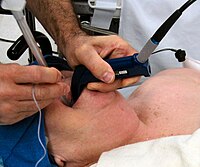
Photo from wikipedia
Dear Editor, I read with voracious interest the article BDepth-dependent changes of obstruction patterns under increasing sedation during drug-induced sedation endoscopy: results of German monocentric clinical trial.^ by Kellner et… Click to show full abstract
Dear Editor, I read with voracious interest the article BDepth-dependent changes of obstruction patterns under increasing sedation during drug-induced sedation endoscopy: results of German monocentric clinical trial.^ by Kellner et al. [1]. I like to start by congratulating Kellner et al. on carrying out a deeply quantitative analysis on the effect of dose on observed upper airway obstruction during drug-induced sedation endoscopy (DISE) [1]. I identified three key points from this study. First, the collapsibility of the upper airway during DISE increases in a dose-dependent manner [1]. Second, majority of studies on DISE do not measure the depth of drug-induced sedation which profoundly limits data interpretation [1]. Third, the obtained obstruction patterns of obstruction during DISE and simulated snoring should be interpreted with regard to sedation depth. My core interest in the article relates to DISE in terms of its observability, interpretability, comparability, repeatability, and objectivity. This letter focuses on four key critical discussion questions. First, BIs upper airway obstruction patterns observed during DISE sedation technique and dose dependent?^ Kellner et al. concluded that collapsibility of the upper airway during DISE is dose-dependent [1]. The analysis presented in their study robustly and clearly demonstrates that obstruction at the velum level, pharyngeal level, and tongue base level is dosedependent [1]. However, only one sedation administration strategy is adopted in the presented study—a bolus application of propofol. Cho et al. and Chang et al. showed that upper airway obstruction patterns observed during DISE is dependent on the sedation administration strategy [2, 3]. Jointly combining both conclusions, it is thus possible that upper airway obstruction patterns observed during DISE is simultaneously dependent on the sedation administration strategy and amount of dose administered. Thereby, this raises questions about the observability of upper airway obstruction patterns during DISE from an anesthesiological viewpoint. Second, BHow should one interpret upper airway obstruction during DISE reported in DISE studies?^ Kellner et al. noted that majority of studies on DISE do not measure the depth of drug-induced sedation which limits data interpretation [1]. In addition, they noted that bispectral index monitoring for monitoring sedation depth during DISE is not common practice [1–3]. Thus, this raises critical questions around the interpretability of anatomical findings based on DISE studies. For a given observed upper airway obstruction for which one does not objectively have an associated bispectral index, the cause of observed upper airway obstruction patterns can be due to natural muscular relaxation, increased administered dose, or chosen sedation administration strategy [1–4]. This makes it strictly impossible to objectively identify the causation of observed upper airway obstruction reported in most DISE studies. Therefore, how can one absolutely interpret DISE findings? Third, BHow should one compare upper airway obstruction patterns during DISE across multiple studies?^Given that one cannot objectively identify the causation of upper airway obstruction during DISE because it could be a natural effect or dose effect or sedation strategy effect, how can one then compare obstructive patterns/anatomical findings across different multiple studies? The European position paper on DISE concluded that there is indeed a problem with comparison of * Esuabom Dijemeni [email protected]; [email protected]
Journal Title: Sleep and Breathing
Year Published: 2017
Link to full text (if available)
Share on Social Media: Sign Up to like & get
recommendations!